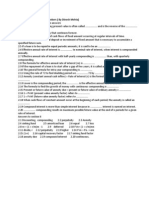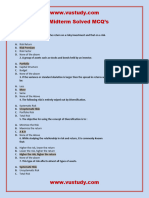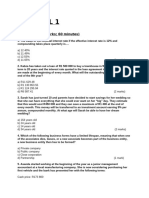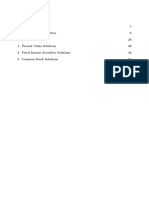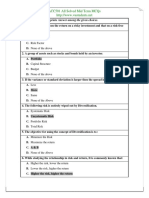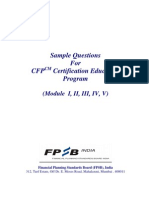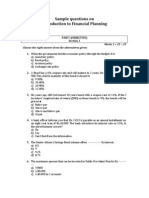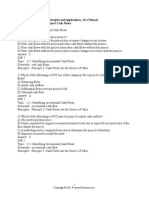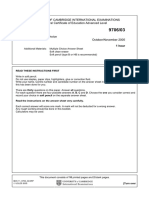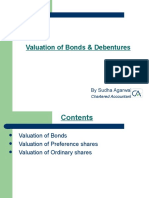CFP Mock Test Introduction To Financial Planning
CFP Mock Test Introduction To Financial Planning
Uploaded by
Deep ShikhaCopyright:
Available Formats
CFP Mock Test Introduction To Financial Planning
CFP Mock Test Introduction To Financial Planning
Uploaded by
Deep ShikhaOriginal Title
Copyright
Available Formats
Share this document
Did you find this document useful?
Is this content inappropriate?
Copyright:
Available Formats
CFP Mock Test Introduction To Financial Planning
CFP Mock Test Introduction To Financial Planning
Uploaded by
Deep ShikhaCopyright:
Available Formats
Mock Test Introduction to Financial Planning
1. Money has time value because:
a. Individuals prefer future consumption to present consumption.
b. Money today is more certain than money tomorrow
c. Money today is wroth more than money tomorrow in terms of purchasing power.
d. There is a possibility of earning risk free return on money invested today.
e. (b), (c) and (d) above.
2. Given an investment of Rs. 10,000 to be invested for one year;
a. It is better to invest in a scheme that pays 10% simple interest.
b. It is better to invest in a scheme that pays 10% annual compound interest.
c . Both (a) and (b) provide the same return
3. Given an investment of Rs. 10,000 for a period of one year, it is better to invest in a scheme that
pays:
a. 12% interest compounded annually
b. 12% interest compounded quarterly
c. 12% interest compounded monthly
d. 12% interest compounded daily
4. Given an investment of Rs. 10,000 over a period of two years, it is better to invest in a scheme that
pays;
a. 10% interest in the first year and 12% in second year.
b. 12% interest in the first year and 10% in second year.
c. Both (a) and (b) above provide the same return
5.The rule of 72 is used to find;
a. Approximate doubling period, given the interest rate (r)
b. Approximate interest rate, given the doubling period (n)
c. Both (a) and (b) above.
6. The relation between effective annual rate of interest (re) and nominal rate of interest (r) is best
represented by;
a. re = (1 + r /m)mn –1
b. re = (1 + r/m)m –1
c. r = (1 + re/m) –1
d. None of the above
7. To find the present value of a sum of Rs. 10,000 to be received at the end of each year for the next 5
years at 10% rate, we use:
a. Present value of a single cash flow table
b. Present value of annuity table.
1 Roots Institute of Financial Markets RIFM
1197, NHBC Mahavir Dal Road, Panipat 132103, Haryana
Ph No. 99961-55000. 99964-55055, Web: www.rifmindia.com, email: info@rifmindia.com
c. Future value of a single cash flow table
d. Future value of annuity table
8. Sinking fund factor is the reciprocal of :
a. Present value interest factor of a single cash flow.
b. Present value interest factor of an annuity.
c. Future value interest factor of a single cash flow.
d. Future value interest factor of an annuity.
9. According to the 'Rule of 69' doubling period of an investment at an interest rate of 15% is :
a. 4.6 years
b. 4.2 years
c. 4.95 years
d. 5.25 years
10. If the effective rate of interest compounded quarterly is 16%, then the nominal rate of interest is :
a. 14.6%
b. 15%
c.14.8%
d. 15.12%
11. If the interest rate on a loan is 1% per month, the effective annual rate of interest is :
a. 12%
b. 12.36%
c. 12.68%
d.12.84%
12. If a loan of Rs. 30,000 is to be paid in 5 annual installments with interest rate of 12% p.a. then the
equal annual installment will be;
a. Rs. 7400
b. Rs. 8100
c. Rs 7812
d. Rs. 8322
13 X took a housing loan of Rs. 25,00,000. The loan is to be redeemed in 120 monthly installments of Rs.
31,000 each to be paid at the end of each month. What is the implied interest rate per annum.
a. 8.50%
b. 8.1%
c. 7.70%
d.9.12%
14. The difference between effective annual rate of interest with monthly and quarterly compounding,
when nominal rate of interest is 10% is;
a. 0.10%
b. 0.14%
c. 0.21%
d. 0.09%
2 Roots Institute of Financial Markets RIFM
1197, NHBC Mahavir Dal Road, Panipat 132103, Haryana
Ph No. 99961-55000. 99964-55055, Web: www.rifmindia.com, email: info@rifmindia.com
15. A bond has a face value of Rs. 1000 and a coupon rate of 10%. It will be redeemed after 4 years at
10% premium. Find the present value of bond at a required rate of 12% :
a. Rs. 1002.80
b.Rs. 960.72
c.Rs. 980.84
d.Rs. 1020.12
16. Axis bank offers 10% nominal interest for a three year fixed deposit to senior citizens. If the
compounding is done quarterly, then effective annual rate of interest is :
a. 10.25%
b.10.38%
c. 10.46%
d.10.52%
17. X deposits Rs. 2500 at the end of every month in a bank for 5 years. If the interest rate offered by
bank is 8% p.a. compounded monthly, the accumulated sum X will get after 5 years will be:
a. Rs. 1,76,802
b. Rs. 1,83,692
c.Rs. 1,91,507
d.Rs. 1,94,752
18. You invest Rs. 1500 at the end of year one and Rs. 2000 at the end of second year and Rs. 5000 each
year from third to tenth. Find the present value of stream at discount rate of 10%
a.Rs. 25,062
b.Rs. 24,712
c. Rs. 26,502
d.Rs. 24,242
19. If you take a loan of Rs 1,00,000 today and return Rs. 1,51,807 after 4 years to clear off the loan,
what effective annual interest rate is paid by you:
a. 12%
b.13%
c.11%
d.12.4%
20. In how much period Rs. 1 becomes Rs. 3 at 12% rate of interest compounded annually.
a. 12 years b. 8 years
c. 10.42 years d. 9.69 years
21. Which of the following statements is true?
a.Frequency of compounding, has no effect on rate of interest.
b.An annuity is a series of cash flows of variable amount.
c.The nominal rate of interest is equal to or more than the effective rate of interest.
d.Cash flows occurring in different time periods cannot be compared unless they are discounted to a
common date.
3 Roots Institute of Financial Markets RIFM
1197, NHBC Mahavir Dal Road, Panipat 132103, Haryana
Ph No. 99961-55000. 99964-55055, Web: www.rifmindia.com, email: info@rifmindia.com
22.If a 12% loan is to be paid back after 10 years, the sinking fund factor will be equal to:
a. 0.03471
b.0.05698
c.0.04231
d. 0.09109
23. Mr X has decided to deposit Rs. 70,000 per year in his public provident fund account for next 15
years. At 8% interest compounded annually, how much money will accumulate in his accounts?
a. Rs. 19,00,648
b. Rs. 20,14,340
c. Rs. 16,05,151
d. Rs. 19,91, 243
24. If a bank offers to double your money in 8 years, what is the effective rate of interest?
a. 8.9%
b. 9.7%
c. 10.2%
d. 9.05%
25. An investment of Rs.5000 in a deep discount bond will return Rs. 1,00,000 in 20 years. Find the
interest rate implicit in the offer?
a. 16.72%
b.15.234%
c.17.121%
d.16.159%
26. A machine is to be replaced after 5 years, when it is expected to cost Rs. 10,00,000. How much equal
sum should be set aside and invested, at the end of each year at 12% p.a. to accumulate the desired
sum?
a. Rs. 1,62,416
b.Rs. 1,57,410
c.Rs.1,75,115
d.Rs.1,53,429
27. Money has time value. It derives this value due to existence of several conditions. Which one of the
following is not one of the conditions contributing to the existence of this value? (1)
A) The fees and commission sources of the firm
B) Possibility of increase in tax rates over time.
C) Ability to buy/ rent assets generating revenue
D) Cost of foregoing present consumptions
28. You are applying for an overdraft facility with the bank. What is the rate of interest you will pay on
this facility? (1)
A) The bank will apply a flat rate of interest on the amount of overdraft allowed to actually utilize.
B) The bank will apply a flat rate of interest on the amount of overdraft allowed to you.
4 Roots Institute of Financial Markets RIFM
1197, NHBC Mahavir Dal Road, Panipat 132103, Haryana
Ph No. 99961-55000. 99964-55055, Web: www.rifmindia.com, email: info@rifmindia.com
C) The bank will apply rate of interest linked to the term deposit rate, on the amount of overdraft
utilized.
D) The bank will apply rate of interest linked to the term deposit rate, on the average amount of
overdraft remaining unutilized from the OD limit.
29. The Nifty has doubled since the last time you advised your client to reduce his equity exposure. The
client is annoyed. What might be the most appropriate action to take immediately? (1)
A) Apologize for wrongly forecasting the market
B) Change his asset allocation by increasing his equity exposure
C) Help the client understand the logic of his asset allocation
D) Rebalance his asset allocation by reducing equity investments
30. A professional indemnity policy protects the insured from risk arising out of _________________. (1)
A) Intentional misconduct
B) Misrepresentation of professional competence
C) Negligence
D) Undisclosed conflict of interest
31. Which of the following is a concurrent indicator of the phase of the business cycle? (1)
A) Wholesale price Index
B) Index of Industrial production
C) Labor costs and capacity utilization
D) Order levels in the manufacturing sector
32. What is the main difference between the personal Financial Planning needs of the employed
and the self-employed? (1)
A) Attitude to risk/Risk appetite
B) Need to fund children’s education
C) Need to fund retirement
D) The extent of employer-provided pension benefits, if any
33. Consider a portfolio of two investments viz. A & B. The sum total of volatility of A and B respectively,
represented by standard deviation of the two investments, will be equal to the volatility of the portfolio
as a whole if _________________.(2)
A) A and B have a correlation of Zero
B) A and B have a correlation of 1
C) The portfolio is equally divided between A and B
D) The return on the portfolio is equal to the sum of returns of A and B
34. Which of the following is a correct interpretation of the Rules of Conduct pertaining to the Ethic of
Confidentiality? (2)
A) A Member must when requested by the client, provide to a person authorized by the client, all
original documents prepared or received by the Member in undertaking the advisory task.
B) A Member owes to the Member’s partners or co-owners a responsibility to act in good faith
(expectations of confidentiality) only while in business together, not thereafter.
C) The Member shall maintain the same standards of confidentiality to employers as to clients.
5 Roots Institute of Financial Markets RIFM
1197, NHBC Mahavir Dal Road, Panipat 132103, Haryana
Ph No. 99961-55000. 99964-55055, Web: www.rifmindia.com, email: info@rifmindia.com
D) Under no circumstance, will any Member divulge any information or knowledge regarding the FPSB
India or its members that they may know or be exposed to.
35. Mr. Rajan.s investment portfolio comprises Rs.2 lakh in equity, Rs.5 lakh in debt and Rs. 1 lakh in his
bank current account. Over one year the returns on equity and debt are 5% and 12%. At the end of the
year to maintain his current asset allocation, he needs to _____________. (2)
A) Do nothing.
B) He needs to move Rs, 10000/- from equity and Rs. 60000/- from debt to cash.
C) He needs move Rs.7500/- to equity from debt and Rs. 8750/-to cash from debt
D) He needs to invest Rs. 70000/- in debt and equity.
36. A 10 year 8.0% bond (Face Value- Rs.1000, interest payable semi-annually) maturing 6 years from
today is available at a yield to maturity of 6.0%. It is likely to be priced at _______________. (2)
A) Rs. 1100
B) Rs. 1149
C) Rs. 1168
D) Rs. 1498
37. Raykar is an accomplished Financial Planner and is also an expert on derivatives and high yielding
bonds. He understands client requirements well and is able to come up with appropriate portfolio
restructuring ideas for clients. He believes in quickly moving clients from one investment to another
through a dynamic process of research and recommendations. What according to the Rules relating to
the Code of Ethics is the most applicable in this case? (2)
A) He does not violate the Rules if he explains to the client the reasons and is able to show that the
moves are appropriate to the client.
B) He does not violate the Rules since he conducts and has access to research and advises on products
relevant to clients based on an understanding of their requirements.
C) He does not violate the Rules since he is an acknowledged expert and knows what is best for his
clients.
D) He violates the Rules as it amounts to active churning of client portfolios.
38.Mrs. & Mr. Arora are aged 55 and 58 years respectively. Both expect to work till they turn 65. Their
only goal is to fund their retirement. Which of the following is likely to be an appropriate asset allocation
strategy for them? (2)
A) 10% sectoral equity, 20% diversified equity, 30% long-term debt, and 40% medium term debt
B) 20% Sectoral equity, 60% diversified equity, 20% long-term debt
C) 30% Sectoral equity, 30% diversified equity, 40% cash/ liquid investments.
D) 80% long-term debt, 20% medium term debt
39. If the post tax rate of return on an investment is 8% and the inflation rate is 5% the real rate of
return is_______________.(2)
A) 3.5%
B) 3.0%
C) 2.86%
D) -3.0%
6 Roots Institute of Financial Markets RIFM
1197, NHBC Mahavir Dal Road, Panipat 132103, Haryana
Ph No. 99961-55000. 99964-55055, Web: www.rifmindia.com, email: info@rifmindia.com
40. Which of the following is a tort of negligence? (4)
A) Mr. Joy was playing golf. He swings a new golf club on the fairway and the head of the club flies off,
and hit another golfer who was standing 20 feet away.
B) Mr. Vishal takes medication that he knows makes him drowsy and then proceeds to drive. He gets
into an accident injuring the passengers in another car.
C) Mrs. Jaya locks Ms. Rani in a room to prevent her from leaving the building
D) Mrs. Priti experienced a sudden surge of chest pain while driving, which causes her to lose control of
her car and hit another car.
7 Roots Institute of Financial Markets RIFM
1197, NHBC Mahavir Dal Road, Panipat 132103, Haryana
Ph No. 99961-55000. 99964-55055, Web: www.rifmindia.com, email: info@rifmindia.com
You might also like
- CFA Level 1 Calculation Workbook: 300 Calculations to Prepare for the CFA Level 1 Exam (2024 Edition)From EverandCFA Level 1 Calculation Workbook: 300 Calculations to Prepare for the CFA Level 1 Exam (2024 Edition)Rating: 4.5 out of 5 stars4.5/5 (6)
- Series 65 Exam Practice Question Workbook: 700+ Comprehensive Practice Questions (2024 Edition)From EverandSeries 65 Exam Practice Question Workbook: 700+ Comprehensive Practice Questions (2024 Edition)No ratings yet
- CB3410 - Last Year Final Exam - With SolutionsDocument11 pagesCB3410 - Last Year Final Exam - With SolutionsKazaf TsangNo ratings yet
- CFP Mock Test Retirement PlanningDocument9 pagesCFP Mock Test Retirement PlanningDeep Shikha100% (4)
- CFP Exam Calculation Workbook: 400+ Calculations to Prepare for the CFP Exam (2019 Edition)From EverandCFP Exam Calculation Workbook: 400+ Calculations to Prepare for the CFP Exam (2019 Edition)Rating: 5 out of 5 stars5/5 (1)
- Problem Sets Present ValueDocument16 pagesProblem Sets Present ValueJoaquín Norambuena EscalonaNo ratings yet
- CFP Mock Test Investment PlanningDocument7 pagesCFP Mock Test Investment PlanningDeep Shikha100% (4)
- Consulting 2Document2 pagesConsulting 2JL OriasNo ratings yet
- Basic CMPD CalculationsDocument33 pagesBasic CMPD CalculationsShubham JhaNo ratings yet
- AtrDocument14 pagesAtrTareq IslamNo ratings yet
- The 250 Retirement Questions Everyone Should AskFrom EverandThe 250 Retirement Questions Everyone Should AskRating: 5 out of 5 stars5/5 (1)
- Fin302 MCQs PDFDocument13 pagesFin302 MCQs PDFkhushi mishaNo ratings yet
- Quiz 2 Set 1Document7 pagesQuiz 2 Set 1Umar Farooq100% (1)
- Accounts and Finance For BankersDocument5 pagesAccounts and Finance For BankersneevcoachingNo ratings yet
- Business Finance Quiz 3Document4 pagesBusiness Finance Quiz 3deeplabuNo ratings yet
- Acc501 Midterm Solved MCQ With Reference by StudentsDocument16 pagesAcc501 Midterm Solved MCQ With Reference by StudentsCREATIVE SKILLEDNo ratings yet
- Acc 501 Midterm Solved MCQ SDocument697 pagesAcc 501 Midterm Solved MCQ Sbani100% (3)
- Accounting and Finance For Bankers - JAIIBDocument19 pagesAccounting and Finance For Bankers - JAIIBAyesha BepariNo ratings yet
- ACC501 Mega File SolvedDocument1,045 pagesACC501 Mega File SolvedOwais KhanNo ratings yet
- Practice Problems For Chapter 2Document5 pagesPractice Problems For Chapter 2Lacey Blankenship100% (2)
- FM I AssignmentDocument3 pagesFM I AssignmentApeksha S KanthNo ratings yet
- 01prelim FIN 103 Answer KeyDocument7 pages01prelim FIN 103 Answer KeyevaNo ratings yet
- Ôn Tập PT ĐTCKDocument72 pagesÔn Tập PT ĐTCKk59.2014730036No ratings yet
- Midterm W07 With SolutionsDocument13 pagesMidterm W07 With SolutionsSupri awasthiNo ratings yet
- Tutorial Lu1-Lu3Document7 pagesTutorial Lu1-Lu32023120468No ratings yet
- Chapter 4 - Time Value of MoneyDocument5 pagesChapter 4 - Time Value of MoneyLayla MainNo ratings yet
- Problem SetsDocument69 pagesProblem SetsAnnagrazia Argentieri100% (1)
- ACC501 All Solved Mid Term MCQsDocument31 pagesACC501 All Solved Mid Term MCQsMuhammad aqeeb qureshi100% (1)
- Acc 501 Midterm Preparation FileDocument22 pagesAcc 501 Midterm Preparation FilesephienoorNo ratings yet
- Exam Practice Question MBADocument11 pagesExam Practice Question MBAsudhakar dhunganaNo ratings yet
- FCM MCQ 1Document15 pagesFCM MCQ 1capt.athulNo ratings yet
- Winter 2007 Midterm With SolutionsDocument13 pagesWinter 2007 Midterm With Solutionsupload55No ratings yet
- ACC501 Mid Term Preparation FileDocument28 pagesACC501 Mid Term Preparation FileMujtaba AhmadNo ratings yet
- 2nd Quarter Exam - GenMAthDocument7 pages2nd Quarter Exam - GenMAthJesmerald LabradorNo ratings yet
- Engineering EconomyDocument11 pagesEngineering Economyintomr871104No ratings yet
- Midterm F08 With SolutionsDocument11 pagesMidterm F08 With SolutionsSupri awasthiNo ratings yet
- Gen Math Final ExamDocument4 pagesGen Math Final ExamMARITESS COLLADONo ratings yet
- 05 TVOM ExerciseDocument2 pages05 TVOM ExerciseSakiNo ratings yet
- C I C (CIC) دهعملا يدنكلا يلاعلا ةسدنهلل - سداسلا نم ربوتكأDocument2 pagesC I C (CIC) دهعملا يدنكلا يلاعلا ةسدنهلل - سداسلا نم ربوتكأabdullah azayemNo ratings yet
- Engineering EconomicsDocument10 pagesEngineering EconomicsLarah PiencenavesNo ratings yet
- Business Finance 2-2 PDFDocument4 pagesBusiness Finance 2-2 PDFThomas nyadeNo ratings yet
- Mock Question I II III IV VDocument24 pagesMock Question I II III IV Vapi-381455783% (6)
- MCQsDocument3 pagesMCQsabdulla.yameenNo ratings yet
- TVM-Q's - GitmanDocument2 pagesTVM-Q's - GitmanNikita AgarwalNo ratings yet
- Engineering EconomicsDocument10 pagesEngineering EconomicsRalph CastilloNo ratings yet
- Time Value of MoneyDocument8 pagesTime Value of MoneyChethan KumarNo ratings yet
- CF Self Assess QuestionsDocument6 pagesCF Self Assess QuestionsLeo Danes100% (1)
- Sample Question CFPDocument15 pagesSample Question CFPapi-3814557100% (7)
- DocDocument6 pagesDoctai nguyenNo ratings yet
- Unit 7 Tutorial 03 Business ManagementDocument2 pagesUnit 7 Tutorial 03 Business ManagementNaufaNo ratings yet
- Dfa1035y 1 2018 2 F PDFDocument9 pagesDfa1035y 1 2018 2 F PDFbugmenomoreNo ratings yet
- Winter 2007 Final ExamDocument15 pagesWinter 2007 Final Examupload55No ratings yet
- Ordinary AnnuityDocument12 pagesOrdinary AnnuityAhmed Mukthar AliNo ratings yet
- Time Value of MoneyDocument14 pagesTime Value of MoneyRakesh Gupta100% (1)
- Sample Questions On Introduction To Financial PlanningDocument7 pagesSample Questions On Introduction To Financial PlanningRavi NagrajNo ratings yet
- BBA 207 Exam 2 - Chapters 4, 5 & 6Document6 pagesBBA 207 Exam 2 - Chapters 4, 5 & 6AdrtyNo ratings yet
- CFP Certification Exam Practice Question Workbook: 1,000 Comprehensive Practice Questions (2019 Edition)From EverandCFP Certification Exam Practice Question Workbook: 1,000 Comprehensive Practice Questions (2019 Edition)Rating: 5 out of 5 stars5/5 (1)
- FPQP Practice Question Workbook: 1,000 Comprehensive Practice Questions (2024 Edition)From EverandFPQP Practice Question Workbook: 1,000 Comprehensive Practice Questions (2024 Edition)No ratings yet
- Narrowing the Development Gap: Follow-Up Monitor of the ASEAN Framework for Equitable Economic DevelopmentFrom EverandNarrowing the Development Gap: Follow-Up Monitor of the ASEAN Framework for Equitable Economic DevelopmentNo ratings yet
- Promoting Green Local Currency Bonds for Infrastructure Development in ASEAN+3From EverandPromoting Green Local Currency Bonds for Infrastructure Development in ASEAN+3No ratings yet
- One Year of Living with COVID-19: An Assessment of How ADB Members Fought the Pandemic in 2020From EverandOne Year of Living with COVID-19: An Assessment of How ADB Members Fought the Pandemic in 2020No ratings yet
- CFP Mock Test Tax PlanningDocument8 pagesCFP Mock Test Tax PlanningDeep Shikha67% (3)
- CFP Mock Test Risk Management and Insurance PlanningDocument7 pagesCFP Mock Test Risk Management and Insurance PlanningDeep Shikha100% (5)
- Chapter 12Document34 pagesChapter 12Kad SaadNo ratings yet
- IAS 19 Employee BenefitsDocument5 pagesIAS 19 Employee Benefitshae1234No ratings yet
- HP-12C Solutions HandbookDocument165 pagesHP-12C Solutions Handbookjfvegaya100% (1)
- FR AS ScannerDocument144 pagesFR AS ScannerPooja GuptaNo ratings yet
- Capital BudgetingDocument71 pagesCapital BudgetingJun Guerzon PaneloNo ratings yet
- TVM & CompoundingDocument8 pagesTVM & CompoundingUday BansalNo ratings yet
- 2005 - Oct - Nov - Paper - 3Document12 pages2005 - Oct - Nov - Paper - 3ktmsharmaaaryanNo ratings yet
- Chapter 6Document38 pagesChapter 6Kad Saad100% (6)
- FM QB New NewDocument22 pagesFM QB New NewskirubaarunNo ratings yet
- Chapter 17Document23 pagesChapter 17Sahaya Grinspan0% (1)
- Finance Interview QuestionsDocument14 pagesFinance Interview QuestionsVivek SequeiraNo ratings yet
- Financial Management - Session 5new1Document32 pagesFinancial Management - Session 5new1niginkabrahamNo ratings yet
- Valuation of DebenturesDocument28 pagesValuation of DebenturesharmitkNo ratings yet
- DCM2102 Unit-02Document10 pagesDCM2102 Unit-02Akash AkashNo ratings yet
- 2023 08 16 Cost - Week 4 Lecture Notes - Time Value of Money (HHG)Document60 pages2023 08 16 Cost - Week 4 Lecture Notes - Time Value of Money (HHG)Neon LalNo ratings yet
- 2019 WTS Financial MathsDocument35 pages2019 WTS Financial MathsJessyNo ratings yet
- Notes Receivable (Chapter 6)Document19 pagesNotes Receivable (Chapter 6)chingNo ratings yet
- Theories of Consumption and InvestmentDocument25 pagesTheories of Consumption and InvestmentSamridh AgarwalNo ratings yet
- 5a - Valuation of Bonds and DebenturesDocument19 pages5a - Valuation of Bonds and DebenturesSudha AgarwalNo ratings yet
- Mathematics of Investment Module 4Document5 pagesMathematics of Investment Module 4Kim JayNo ratings yet
- Unit ACTIVITY 3Document2 pagesUnit ACTIVITY 3Alliyah NicolasNo ratings yet
- CH 5 Time Value of MoneyDocument31 pagesCH 5 Time Value of MoneyMd. Arjit IsalmNo ratings yet
- FM BY SK As @3 April 2006Document299 pagesFM BY SK As @3 April 2006OnyangoVictorNo ratings yet
- Notes PDFDocument57 pagesNotes PDFKashif ZaheerNo ratings yet
- The Time Value of MoneyDocument79 pagesThe Time Value of MoneyShivanitarunNo ratings yet
















